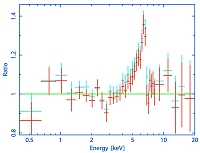Black Holes in a radar trap
23 February 2005
Using the X-ray Satellite XMM-Newton researchers measure velocities near the speed of light in the vicinity of cosmic mass monsters.European astronomers succeeded for the first time to confirm the signatures predicted near black holes by Albert Einstein's theory of Relativity in the light of the cosmic X-ray background. The group of scientists led by Günther Hasinger, director at the Max-Planck-Institute for extraterrestrial Physics in Garching near Munich, could identify the spectral fingerprint of iron atoms. They observed a strong, relativistically smeared iron line in the average spectrum of roughly 100 active galaxies, whose X-ray light had been emitted when the Universe was less than half of its current age.
The whole sky is filled with a diffuse, high energy glow: the cosmic X-ray background. In the last years the astronomers could show, that this radiation can almost completely be associated with individual objects. Similarly, Galileo Galilei in the beginning of the 17th century resolved the light of the Milky Way into individual stars. The X-ray background originates in hundreds of millions of supermassive black holes, which feed from matter in the centres of distant galaxy systems. Because the black holes are accreting mass, we observe them in the X-ray background during their growth phase. In today's Universe, massive black holes are found in the centres of practically all nearby galaxies.
 |
|
Figure 1: Artist's concept of the relativistic flow of matter around a fast rotating black hole in the centre on an accretion disk (orange). Copyright: MPE |
In a way similar to the radar traps with which the police identify speeding cars, the relativistic speeds of iron atoms circling the black hole can be measured through a shift in the wavelength of their light. Through a combination of the effects predicted by Einstein's special and general theory of relativity, however, a characteristically broadened, asymmetric line profile, i.e. a smeared fingerprint, is expected in the X-ray light of black holes. Special relativity postulates that moving clocks run slow, and general relativity predicts that clocks run slow in the vicinity of large masses. Both effects lead to a shift of the light emitted by iron atoms into the longer wavelength part of the electromagnetic spectrum. However, if we observe the matter circling in the accretion disk (see Figure 1) from the side, the light from atoms racing towards us appears shifted to shorter wavelengths and much brighter than that moving away from us. These relativistic effects are stronger, the closer the matter gets to the black hole. Because of the curved spacetime they are strongest in fast rotating black holes. In the past years, measurements of relativistic iron lines have been possible in a few nearby galaxies – for the first time in 1995 with the Japanese ASCA satellite.
Now the researchers around Günther Hasinger of the Max-Planck-Institute for extraterrestrial Physics, jointly with the group of Xavier Barcons at the Spanish Instituto de Física de Cantabria in Santander and Andy Fabian at the Institute of Astronomy in Cambridge, UK have uncovered the relativistically smeared fingerprint of iron atoms in the average X-ray light of about 100 distant black holes of the X-ray background (see Figure 2). The astrophysicists utilized the X-ray observatory XMM-Newton of the European Space Agency ESA. They pointed the instrument to a field in the Ursa Major constellation for more than 500 hours and discovered several hundred weak X-ray sources. Because of the expansion of the Universe the galaxies move away from us with a speed increasing with their distance and thus their spectral lines all appear at different wavelength; the astronomers had first to correct the X-ray light of all objects into the rest frame of the Milky Way. The necessary distance measurements for more than 100 objects were obtained with the American Keck-Telescope. After having co-added the light from all objects, the researchers were very surprised about the unexpectedly large signal and the characteristically broadened shape of the iron line.
From the strength of the signal they deduced the fraction of iron atoms in the accreted matter. Surprisingly, the chemical abundance of iron in the "nutrition" of these relatively young black holes is about three times higher than in our Solar system, which had been created significantly later. The centres of galaxies in the early Universe therefore must have had a particularly efficient method to produce iron, possibly because violent star forming activity "breeds" the chemical elements rather quickly in active galaxies. The width of the line indicated that the iron atoms must radiate rather close to the black hole, consistent with rapidly spinning black holes. This conclusion is also found indirectly by other groups, who compared the energy in the X-ray background with the total mass of "dormant" black holes in nearby galaxies.
Original Publication
Alina Streblyanska, Günther Hasinger, Alexis Finoguenov, Xavier Barcons, Silvia Mateos, Andy Fabian: XMM-Newton observations of the Lockman Hole: III. A relativistic Fe line in the mean X-ray spectra of type-1 and type-2 AGN, A&A Press Release AA/2004/1977, astro-ph/0411340.
Contact
Prof. Dr. Günther Hasinger
Max-Planck-Institut für extraterrestrische Physik
Garching bei München, Germany
Tel.: +49 (89) 30000-3401
Fax: +49 (89) 30000-3403
E-Mail: grh xray.mpe.mpg.de
xray.mpe.mpg.de
Prof. Dr. Xavier Barcons
Instituto de Física de Cantabria (CSIC-UC)
Santander, Spain
Tel: +34 942 201461
E-Mail: barcons ifca.unican.es
ifca.unican.es
Prof. Dr. Andy Fabian
Institute of Astronomy
Cambridge, UK
Tel: +44 (1) 223-337548
E-Mail: acf ast.cam.ac.uk
ast.cam.ac.uk


